Nvidia Announces Jetson Nano Dev Kit & Board: X1 for $99
by Andrei Frumusanu on March 18, 2019 7:00 PM EST- Posted in
- NVIDIA
- Tegra X1
- Jetson
- Jetson Nano
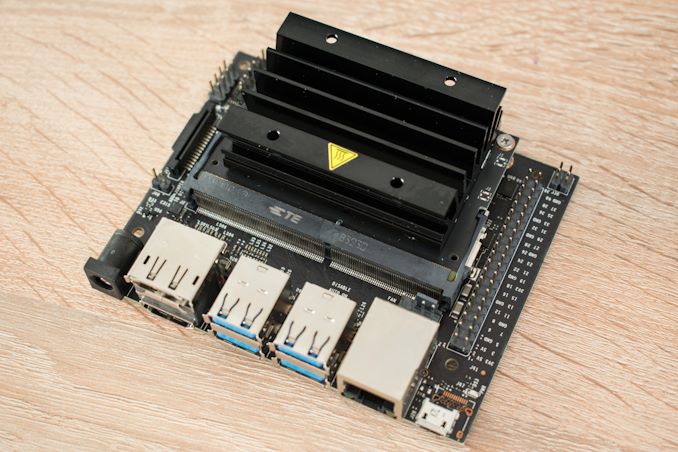
Today at GTC 2019 Nvidia launched a new member of the Jetson family: The new Jetson Nano. The Jetson family of products represents Nvidia new focus on robotics, AI and autonomous machine applications. A few months back we had the pleasure to have a high level review of the Jetson AGX as well as the Xavier chip that powers it.
The biggest concern of the AGX dev kit was its pricing – with a retail price of $1299, it’s massively out of range of most hobbyist users such as our readers.
The new Jetson Nano addresses the cost issue in a quite dramatic way. Here Nvidia promises to deliver a similar level of functionality than its more expensive Jetson products, at a much lower price point, and of course at a lower performance point.
The Jetson Nano is a full blown single-board-computer in the form of a module. The module form-factor and connector is SO-DIMM and is similar to past Nvidia modules by the company. The goal of the form-factor is to have the most compact form-factor possible, as it is envisioned to be used in a wide variety of applications where a possible customer will design their own connector boards best fit for their design needs.
At the heart of the Nano module we find Nvidia’s “Erista” chip which also powered the Tegra X1 in the Nvidia Shield as well as the Nintendo Switch. The variant used in the Nano is a cut-down version though, as the 4 A57 cores only clock up to 1.43GHz and the GPU only has half the cores (128 versus 256 in the full X1) active. The module comes with 4GB of LPDDR4 and a 16GB eMMC module. The standalone Jetson Nano module for use in COTS production will be available to interested parties for $129/unit in quantities of 1000.
Naturally, because you can’t do much with the module itself, Nvidia also offers the Jetson Nano in the form of a complete computer: The Jetson Nano Developer Kit. Among the advantages of the Kit is vastly better hardware capabilities compared to competing solutions, such as the performance of the SoC or simply better connectivity such as 4 USB full (3x 2.0 + 1x 3.0) ports, HDMI, DisplayPort and a Gigabit Ethernet port, along with the usual SDIO, I2C, SPI, GPIO and UART connectors you’re used to on such boards. One even finds a M.2 connector for additional WiFi as well as a MIPI-CSI interface for cameras.

Jetson AGX Dev Kit vs Jetson Nano Dev Kit
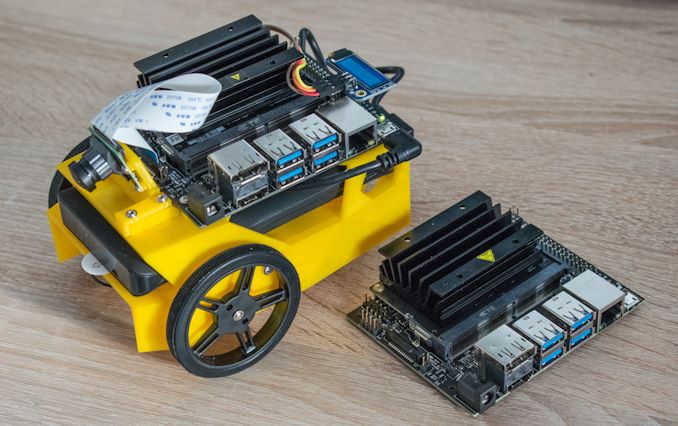
Jetbot with Jetson Nano Dev Kit vs Jetson Nano Dev Kit
The Jetson Nano Development Kit can be had for only $99. One way Nvidia reaches this price is through the omission of on-board storage, and the kit is driven purely by microSD card. Availability starts today.
We have the Jetson Nano in-house and will seeing what fun things Nvidia cooked up for us soon!


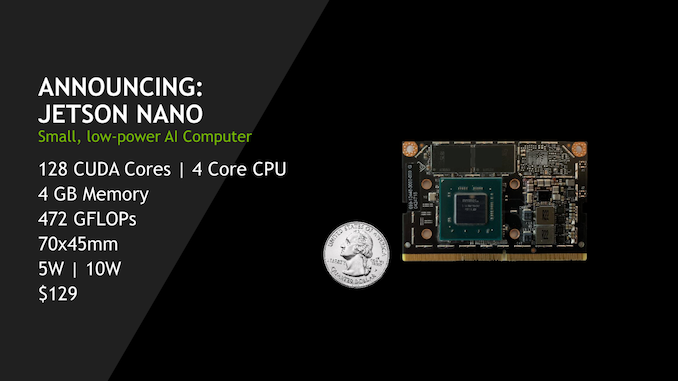
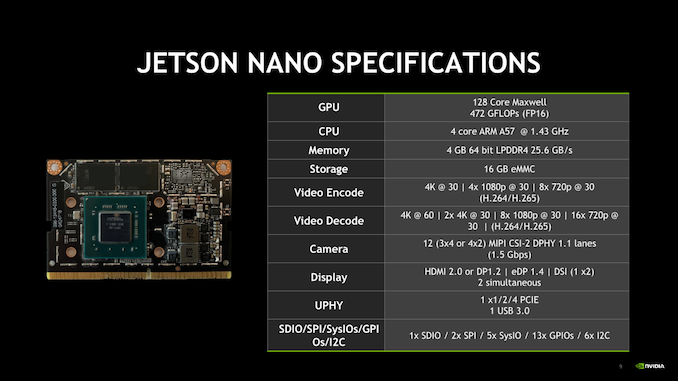

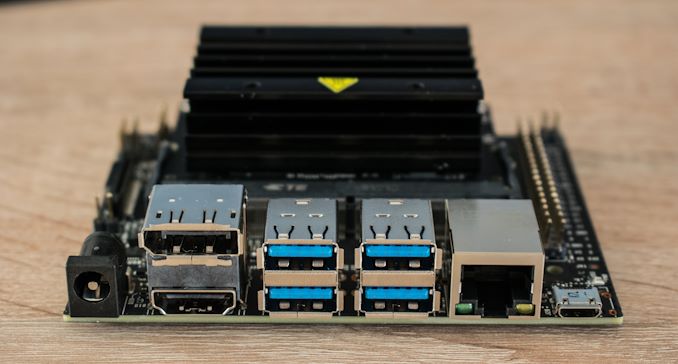
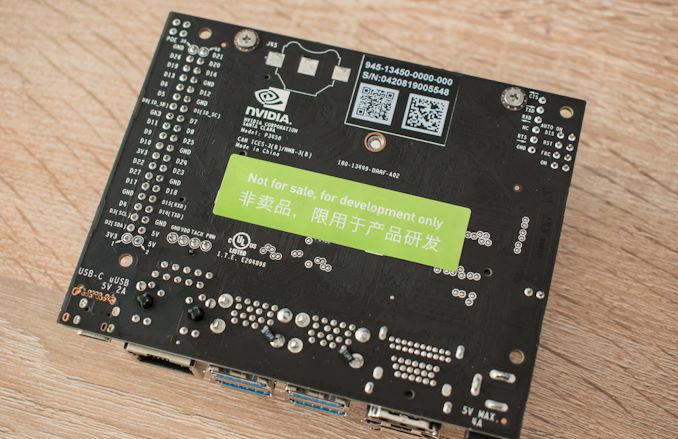








49 Comments
View All Comments
HardwareDufus - Tuesday, March 19, 2019 - link
it better smash the raspberry pi... it cost more than 3 times as much..... raspberry pi just needs an a/d converter and an xtra i2c channel...… oh and real ethernet... that's what i'm hoping for rasp-pi4PeachNCream - Tuesday, March 19, 2019 - link
What do you mean by "real ethernet?" Even my RPi 2 has a tangible port that I can reach out and touch. It doesn't seem unreal, imaginary, intangible, or whatever else is the opposite of real to me and, best of all, it moves data packets.HardwareDufus - Tuesday, March 19, 2019 - link
It's there and useable. However, The Raspberry Pi 3 shares the same SMSC LAN9514 chip as its predecessor, the Raspberry Pi 2, adding 10/100 Ethernet connectivity and four USB channels to the board. As before, the SMSC chip connects to the SoC via a single USB channel, acting as a USB-to-Ethernet adaptor and USB hub. USB Chip.kgardas - Tuesday, March 19, 2019 - link
Yes, but internally it's connected to USB so you do have USB latency/speed on this ethernet which is kind of sad.mode_13h - Tuesday, March 19, 2019 - link
Exactly.mode_13h - Tuesday, March 19, 2019 - link
Because the Pi's ethernet is a joke. You clearly haven't used it for anything (except, maybe reaching out and touching).PeachNCream - Thursday, March 21, 2019 - link
Good grief, I had no idea it was tied in via USB. So no, I haven't worked it very hard at all. VNC access into the GUI for occasional tweaks, updates, and restarts were about the extent of it and it worked passably well for that sort of thing. I can't imagine trying to use the Pi for anything more intensive given that configuration.So yes, agreed, this is indeed fictional ethernet to say the least.
mode_13h - Thursday, March 21, 2019 - link
Thanks for your candor.abufrejoval - Tuesday, March 19, 2019 - link
thanks for the link (and the article, Andrei!), just ordered one: Funny Easter egg, sort of squarish ;-)HStewart - Tuesday, March 19, 2019 - link
You are welcome. I hope it helps and I am debating but my RPI 2 are sitting in box ( 2 of them ) along with Adreno.